Contents
Pruning cherries in the spring is essential to keep the plant healthy and to maximize yields. With proper pruning according to the rules, the cherry begins to grow only better and pleases with a large number of delicious fruits.
When to prune cherries: in spring or autumn
Gardeners prune cherry trees in both spring and autumn. However, the autumn haircut procedure is practiced less frequently, since it carries unnecessary risks.
Removing branches and shoots always weakens the plant. In the spring, it quickly recovers, but in the fall it may not have time to get stronger before the cold weather, and in this case, the frost will cause serious damage to it.
Benefits of Spring Cherry Pruning
Pruning in the spring has several advantages.
- Fast plant recovery. With the beginning of the growing season, the cherry begins to actively develop, and the inevitable injuries received during pruning do not harm its health.
- Better fruiting. Pruning a fruiting plant in the spring relieves it of weakened and too old shoots. Nutrients go to the development of young shoots and ovaries, respectively, the yield increases.
- Protection against pests and diseases. The presence of diseased and weak branches, as well as excessive thickening, increase the likelihood of damage by ailments. Pruning in the spring strengthens the health of the fruit plant and helps prevent fungal diseases and pest attacks.
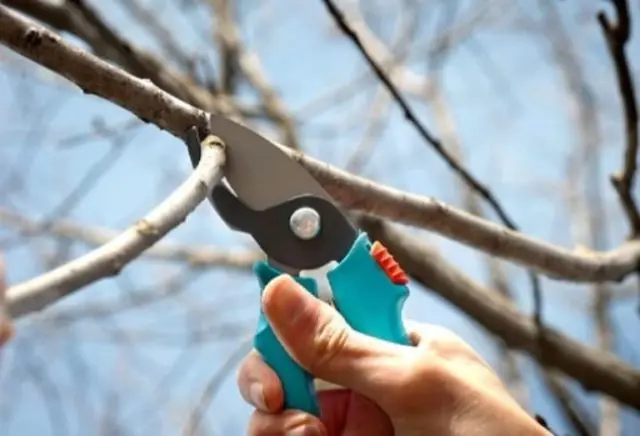
Spring pruning is less traumatic than fall pruning.
You can also prune cherries in the spring to form a crown. After the foliage appears, the cherry will immediately take on a beautiful shape, and the gardener will not have to wait until the next season, as with autumn pruning.
When is the best time to prune cherries in spring?
The timing of pruning in the spring depends on the region of growth and on weather conditions. Pruning should be done at the end of the cold weather, but before the start of sap flow.
In the middle lane and southern regions, cherry pruning in the spring and crown formation is usually carried out in the middle or end of March. In the northern regions, the plant should be cut in mid or late April. It is important to finish pruning before the buds begin to open.
How to prune cherries in spring: step by step diagrams for beginners
The pruning algorithm in spring depends on the age of the cherry. Young, fruiting and old plants are trimmed in different ways.
How to prune cherries in spring according to the classic pattern
The standard pruning scheme in the spring is used for adult tree-like plants that have already entered the fruiting period. The main purposes of pruning are to increase productivity, crown formation and sanitary thinning.
The classic scheme looks like this:
- the cherry tree is carefully examined and all broken, weakened, diseased branches are removed from it, which no longer participate in fruiting, but take away some of the nutrients;
- after that, last year’s shoots are shortened – this stimulates the formation of new bouquet branches with flower and vegetative buds;
- branches that are 3 years old or more can be cut whole, and side shoots on branches 5 years old or more can also be removed;
If the tree exceeds 3 m in height, you need to cut off the tops of the skeletal branches, the plant will stop developing in the vertical direction, but will begin to release side branches more actively.
Pruning cherries when planting in spring
The first pruning is carried out immediately after planting in the soil. This allows you to form the right beautiful crown and also stimulates the growth of roots. The scheme of how to properly cut cherries in spring looks like this:
- the seedling is left with the main vertical shoot, or trunk, and no more than 6 side branches, which in the future will make up the “skeleton”;
- the distance between the frame processes is left about 10 cm;
- at the seedling, all shoots that grow crooked or towards the trunk are cut off;
- also cut off shoots that intersect with each other and impede the development of each other.
If there is already growth at the base of the seedling in the roots, it must also be removed. It does not bring benefits, but takes away nutrients.
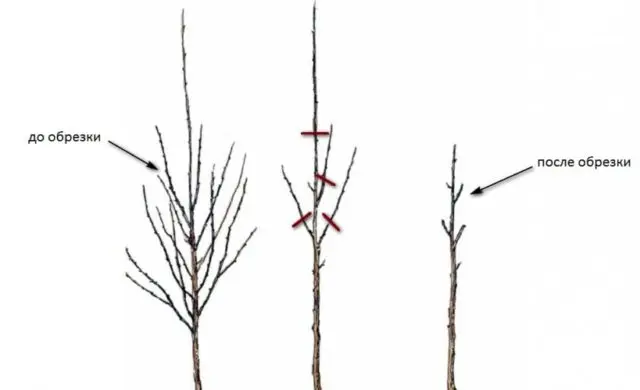
For the first time, cherry tree shoots are pruned immediately after being transferred to the soil.
How to prune young cherries in spring
Special care is required for a young fruit tree from 2 to 5 years of life. A video of pruning young cherries in spring for beginners can be found on the net, and the basic rules for cutting look like this:
- In the second year of life, all dry, diseased and crookedly growing shoots are removed from the plant. The branches formed in the gaps between the frame ones are also eliminated, and the lateral processes are shortened. All shoots that thicken the crown of a young tree are cut “into a ring” – flush with the trunk.
- In the third year, it is necessary to shorten shoots by a few centimeters, the length of which exceeded 60 cm. Of all the branches that have grown over the past year, only 2 or 3 are left to form the second level of branches – other shoots can be removed.
- In the fourth year, the young plant is thinned out again, removing all improperly growing shoots that contribute to thickening. The branches are trimmed, making sure that the lower ones are longer than the upper ones, and the upper ones are 10 cm away from the top of the tree. During pruning, 2-3 shoots can be left to form the third level of cherry.
Thus, in the fifth year of life, a young plant should consist of a main trunk and about 15 frame branches, and semi-skeletal shoots should be located on the sides of the main branches. When carrying out the next haircut, all excess shoots are removed and eliminated withered and twisted branches.
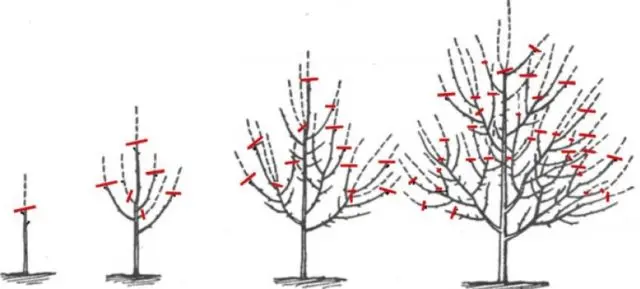
The diagram shows pruning options for trees of different ages.
How to form fruit-bearing cherries in spring
When pruning an adult fruit-bearing tree, the main goal is to remove all the extra shoots that take away vitality from the cherry. The scheme for pruning cherries in the spring for beginners is as follows:
- they cut down all the shoots that thicken the crown of the plant, and leave only horizontal branches;
- cut off the processes that prevent the proper growth of skeletal branches;
- if the main trunk rises above the skeletal branches by more than 20 cm, it is cut at the top by a few centimeters;
- last year’s shoots are slightly pruned to stimulate the growth of new branches;
- skeletal branches are cut to the point where the side shoots begin to branch.
Anti-aging pruning of old cherries in spring
For cherries that have reached the age of ten, the so-called anti-aging pruning is required. First of all, it increases the life of the culture as a whole, and the haircut also has a positive effect on fruiting. The procedure is carried out in several ways:
- Cutting off the top. The video of pruning cherries in the spring for beginners shows that the top of the trunk at a height of 2,5-3 m is eliminated from old trees – this stimulates the growth of lateral branches. After their appearance, only the most promising, even and well-located shoots should be left, and the rest should be removed.
- Shortening frame branches. The main skeletal shoots are cut to the point of branching, in other words, to the point where new young branches begin to grow upwards.
When carrying out anti-aging pruning, it is necessary to act gradually and without haste. It is not recommended to cut all the old branches in one spring – this can cause too much damage to the tree. It is better to remove several branches annually so that the tree is completely renewed within a few years.
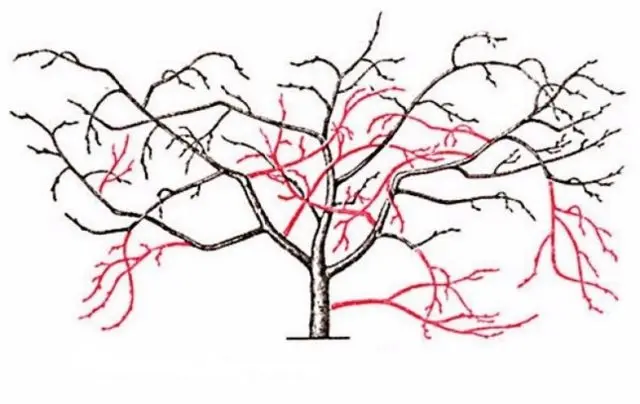
Trim an old plant carefully and gradually.
Pruning running cherries in spring
Sometimes pruning in the spring is required for a heavily thickened tree that has not been cut for a long time. The algorithm in this case remains standard – all old, weak, improperly growing branches are removed, leaving only promising and strong young shoots. At the same time, it is important not to rush and cut off several old branches annually so that rejuvenation takes place gradually.
How to prune cherries in spring, depending on the type
The pruning algorithm in spring depends not only on the age, but also on the variety of the fruit tree. Cherries are tree-like and bushy, dwarf and columnar, in all cases the pruning rules will differ slightly.
How to prune felt cherries in spring
Felt cherry is a very productive crop that begins to bear fruit within a year after planting. In this case, the plant is prone to thickening and rapid growth. Therefore, pruning felt cherries in the spring should be given special attention.
Every spring, the plant is trimmed, removing all weak and diseased branches, as well as shoots that grow towards the trunk.
Last year’s branches, on which the main crop is formed, are cut by a third, provided that they are extended by more than half a meter. The height of the plant is maintained at a level of 2-2,5 m – this is the optimal growth for felt cherries.
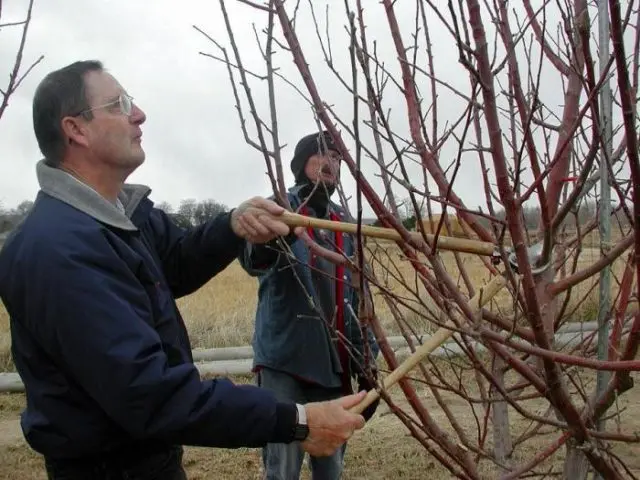
Felt cherries need to regularly cut off strong side shoots.
A well-formed plant should have about 10 main branches that make up the frame. Lateral shoots in adult trees are regularly cut “into a ring”, while not affecting the frame branches and the central part of the crown.
Pruning bush cherries in spring
The bush variety also has a high yield, but is prone to active thickening and gives basal shoots. Therefore, it is necessary to thin out the shrub very carefully, otherwise the cherry will bring less fruit, and they will be small. Cherry pruning in spring for beginners in pictures offers:
- pruning weak and broken branches, as well as shoots competing with the main trunk;
- remove branches growing down or towards the inside of the crown;
- cut shoots more than 50-60 cm in length by a third, and cut skeletal and semi-skeletal branches to a dormant bud;
- thin out branches that thicken the silhouette of the plant.
In any beginner pruning video for bush cherries in spring, it is emphasized that the shrub bears fruit exclusively on annual shoots. Therefore, young branches cannot be cut off from him – this negatively affects the yield.
Pruning scheme for columnar cherries in spring
There is an opinion that slender and straight columnar cherries, in principle, do not need pruning. In fact, this is not so, first of all, the trees need an annual sanitary haircut, and, in addition, they periodically need to maintain the shape of the crown.
The algorithm for trimming a columnar cherry comes down to the following steps:
- after 3 years of life, every spring, the side branches of the tree are pinched at a distance of 40 cm from the trunk;
- after the cherry reaches a height of approximately 2,5 m, the top of the plant is cut off so as not to allow it to stretch upwards too much.
Without annual pruning in the spring, the columnar cherry will lose its yield, since even its elongated crown will thicken with extra shoots.
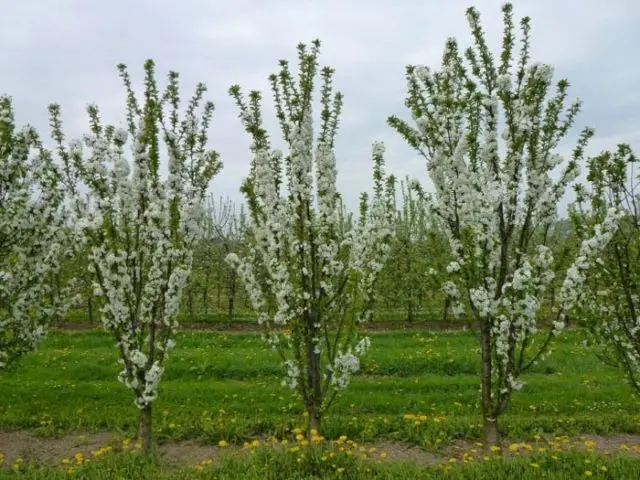
The columnar tree needs to be shaped despite its slender silhouette.
Pruning dwarf cherries in spring
Dwarf varieties of fruit trees up to 2 m in height are very popular due to their compact size and high yield. Also, dwarf cherries are characterized by precocity, usually you can pick berries in the second year after planting the plant.
The procedure for pruning dwarf cherries consists mainly in sanitary thinning of the crown. Weak and crooked shoots should be removed annually so that they do not interfere with the growth of fruiting branches. After 8-10 years of life, the bonsai is rejuvenated in the standard way – they begin to gradually remove the old skeletal branches, replacing them with younger side shoots.
Cherry pruning rules
Regardless of the scheme and goals in the course of pruning, you must follow the time-tested rules. When they are performed, a haircut will not harm the tree, but will only contribute to healthy growth and fruiting.
Preparation of tools and materials
To thin out cherries in the spring, the gardener will need several tools:
- a garden saw, or a hacksaw for wood – with its help, thick skeletal branches with a large diameter are removed;
- secateurs – a tool designed for cutting thin young shoots and twigs;
- lopper – a garden tool used to remove small branches located at an awkward angle or in hard-to-reach places.
Before carrying out the procedure, the instruments must be carefully sharpened. Cuts on the cherry should be as even and smooth as possible, so the tree will not get unnecessary injuries and can recover faster after pruning.
Before thinning cherries, tools are recommended to be disinfected. You can use a solution of potassium permanganate for this, it kills bacteria well and is not dangerous for plant tissues.
In addition to tools, for pruning a cherry tree, you will need to prepare thick gardening gloves that will protect your hands from cuts. If the tree is tall enough, take a ladder to get access to the top of the cherry tree and the top shoots.
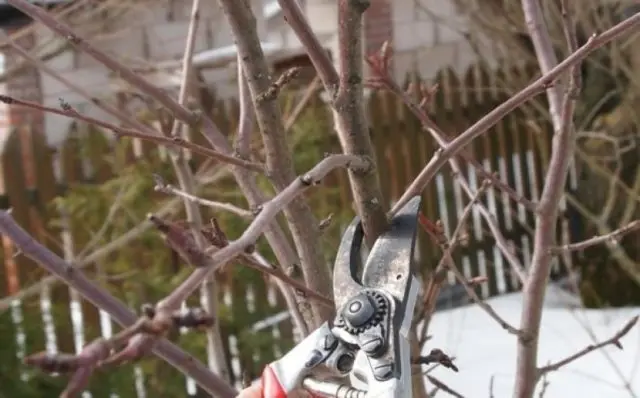
All pruning tools must be sharp and sterile.
How to cut a cherry
During pruning, you must adhere to the following recommendations:
- Thick old branches with a diameter of more than 5 cm are cut with a hacksaw, medium and thin young shoots up to 3 cm in girth are removed with a pruner or lopper. Using the right tool for branches of different thicknesses is very important, as a quick and even cut minimizes injury to the tree.
- To access the upper shoots use a ladder. Climbing the branches of the tree itself is undesirable. First of all, it is traumatic, and besides, you can accidentally break thin young shoots, which will cause unnecessary harm to the cherry.
- It is necessary to cut the branches of the fruit tree carefully and quickly, at the chosen place of the cut. You can not inflict unnecessary wounds on the shoots and unnecessarily leave scratches on the bark – this will negatively affect the health of the cherry.
- It is recommended to cut the shoots at an angle of 40-45 ° C, and the cut line should recede 5 mm from the inner or outer bud.
- When cutting skeletal branches “on a ring”, you need to make a neat cut along the upper edge of the ring at the base of the branch. It is impossible to cut off the shoot along with the ring, because of this the wood may crack, a hollow will appear.
Immediately after the spring shearing, all removed parts of the fruit tree must be collected and burned. Do not leave branches lying on the ground, as this will increase the risk of infection by pests and fungal spores.
Slicing processing
So that the infection does not get into the sections on the trunk and branches of the tree, they must be treated with antiseptic solutions, for example, copper sulfate or Bordeaux liquid. After that, the sections are covered with garden pitch.
If the processing is neglected, then in the places of cuts the wood may begin to rot, and abundant gum is also likely to appear.
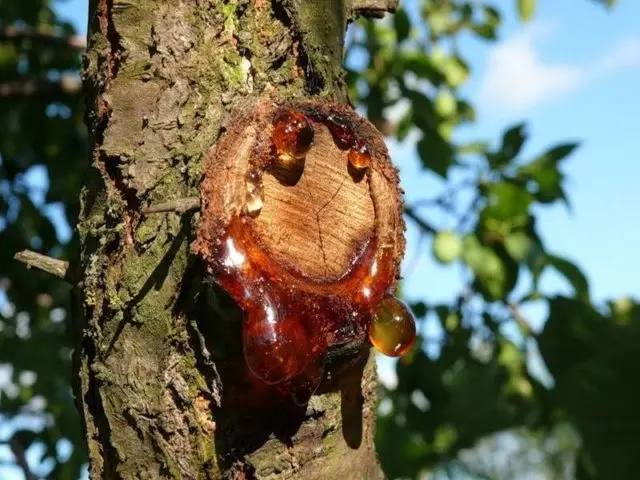
Fresh cuts should be immediately treated with garden pitch.
Tree care after pruning
It is recommended to prune cherries in the spring, since such a haircut is the least traumatic for fruit trees. However, even after it, the cherry needs minimal care. It consists in the following:
- all cut branches are removed from the trunk circle and burned at the far end of the site;
- with the beginning of the growing season, cherries are fed with nitrogen fertilizers, they help restore strength and increase green mass;
- shortly before flowering, the tree is treated for diseases and pests, while paying special attention to the places of cuts.
Additional watering after pruning is required only if the spring is dry and warm and the tree is dehydrated.
Conclusion
Cherry pruning in the spring is carried out to increase productivity and to rejuvenate an adult fruit tree. The thinning scheme depends both on the age of the cherry and on its type, but in general, the procedure is not particularly difficult for the gardener.









